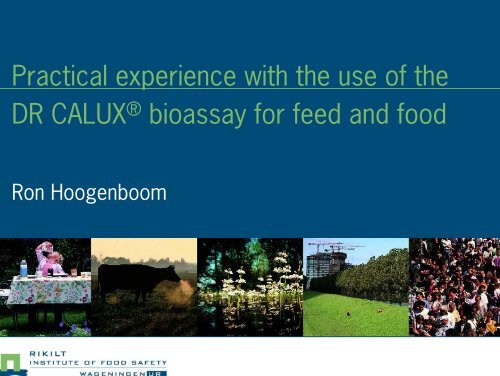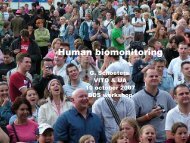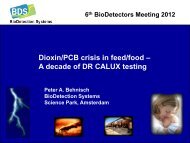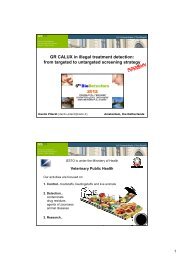Practical experience with the use of the DR CALUX® bioassay for ...
Practical experience with the use of the DR CALUX® bioassay for ...
Practical experience with the use of the DR CALUX® bioassay for ...
- No tags were found...
You also want an ePaper? Increase the reach of your titles
YUMPU automatically turns print PDFs into web optimized ePapers that Google loves.
<strong>Practical</strong> <strong>experience</strong> <strong>with</strong> <strong>the</strong> <strong>use</strong> <strong>of</strong> <strong>the</strong><strong>DR</strong> CALUX ® <strong>bioassay</strong> <strong>for</strong> feed and foodRon Hoogenboom
January 2006: Dioxins in recycled fat from gelatin productionSamplenumberLevelResponse (RLUs)Decisionpg TEQ/gmeanSDBlank fat6713Ref 10.4752Ref 21.01026Ref 31.516813Ref 43.124637200163193?Hoogenboom et al. 2007
January 2006: Dioxins in recycled fat from gelatin productionSamplenumberLevelResponse (RLUs)Decisionpg TEQ/gmeanSDBlank fat6713Ref 10.4752Ref 21.01026Ref 31.516813Ref 43.124637200163193?94177suspectedHoogenboom et al. 2007
Application <strong>of</strong> <strong>DR</strong> CALUX assay at RIKILT• Gelatin first incident discovered by <strong>DR</strong> CALUX ® ,• but <strong>DR</strong> CALUX widely <strong>use</strong>d <strong>for</strong> monitoring and,• in o<strong>the</strong>r incidents, like ….
Food and feed incidentsBrazilian citrus pulp 1998Belgian PCB fat 1999Wild eelGerman kaolinic clay 1999Belgian cholin chloride 2002German bakery waste 2003Free range eggsPotato peels/kaolinic clay 2004Gelatin fat/Hydrochloric acid 2006
Screening method <strong>for</strong> dioxins• Requirements in 1990• quick and relatively cheap• high sample throughput• rapid expansion <strong>of</strong> capacity (crisis)• no false-negatives, few false-positives• sensitive at low levels• obeying <strong>the</strong> TEQ-principle• Still valid in 2007?• Clean-up GC/HRMS improved• And thus throughput, expansion, and costs?
Current <strong>use</strong> <strong>of</strong> <strong>DR</strong> CALUX ®• Test especially <strong>use</strong>ful in large monitoring programs• Few samples <strong>with</strong> high response• <strong>DR</strong> CALUX will detect o<strong>the</strong>r (persistent) AhR-agonists• Brominated dioxines• Mixed halogenated dioxins• O<strong>the</strong>rs?
Application <strong>for</strong> dioxins and dl-PCBs in food and feed• Clean-up procedure• Sensitivity• Validation• Test strategy
<strong>DR</strong> CALUX <strong>bioassay</strong>: screening assayClOClClOClClClOOClClLucLuciferin+ATPAarts et al. 1993
Clean-up <strong>of</strong> samples (increased selectivity)• Fat extraction• acid silica clean-up (6-8 h)• CALUX-assay (24 h incubation)
Quantitative approach: calibrationSeveral options:• TCDD calibration curve (most common)• Dioxin/PCB mixture (not applied)• “Reference” samples (RIKILT)
Quantitative approach35003000Response (RLUs)2500200015001000Level in testsample50000.1 1 10 100 1000Concentration TCDD (pM)
JRC: Results chicken feed (n=10)FeedGC/MSMeanUnc. Int.srRSD rsRRSD R10.0420.7631.8543.95Gizzi et al. 2005
Chicken feed: individual results3CALUX (ng TCDD eq/kg)21y=x0762985 <strong>with</strong> Corr.Coeff. > 0.9700.00 0.50 1.00 1.50 2.00 2.50 3.00 3.50 4.00 4.50GC/MS (ng TEQ/kg)
JRC: Results chicken feed (n=10)FeedGC/MSMeanUnc. Int.srRSD rsRRSD R10.040.250.14-0.360.09370.187120.760.690.46-0.930.25370.375331.851.030.87-1.180.14140.252443.951.631.15-2.100.85520.7546Background highRecovery lowGizzi et al. 2005
Use <strong>of</strong> reference samples• Matrix/pattern specific reference materials:• to correct <strong>for</strong> possible contaminants from solvents• Including interaction fat and acid silica• to correct <strong>for</strong> possible “recovery losses”
“Recovery”Determined by different factors:• Loss <strong>of</strong> dioxins and PCBs during clean-up• Evaporation is critical step• Loss <strong>of</strong> DMSO (keeper) during evaporation• DMSO increases response in <strong>the</strong> test• Quality <strong>of</strong> curve-fit, especially at lower concentrations• Often poor fit at low levels: underestimation <strong>of</strong> levelSee Hoogenboom et al. TRAC 2006
Curve-fit and DMSO-effectB0.5%DMSO
“Recovery”Determined by different factors:• Loss <strong>of</strong> dioxins and PCBs during clean-up• Evaporation is critical step• Loss <strong>of</strong> DMSO (keeper) during evaporation• DMSO increases response in <strong>the</strong> test• Quality <strong>of</strong> curve-fit, especially at lower concentrations• Often poor fit at low levels: underestimation <strong>of</strong> level• Difference between REPs and WHO-TEF values• REPs in general lower than WHO-TEQ: underestimationSee Hoogenboom et al. TRAC 2006
• Relationship CALUX-REPs and WHO-TEFs
Dose-response curves <strong>for</strong> dioxins and PCBsBovee et al. 199
CALUX REPs versus WHO-TEFsCongenerWHO-TEFBoveeLaierBenischScippoNew TEFs2,3,4,7,8-PeCDF0.50.30.60.50.40.31,2,3,6,7,8-HxCDF0.10.070.040.090.12,3,7,8-TCDD1111111,2,3,7,8-PeCDD10.510.50.511,2,3,6,7,8-HxCDD0.10.30.10.060.1PCB 1260.10.070.20.070.040.1PCB 1690.010.0020.0030.00080.03PCB 1181.10 -45.10 -63.10 -6ndrcNr3.10 -5PCB 1051.10 -42.10 -61.10 -5Nr3.10 -5PCB 1565.10 -44.10 -52.10 -42.10 -42.10 -53.10 -5
Role <strong>of</strong> CALUX-REPs in “recovery”Lower REPs lead tounderestimation <strong>of</strong> content1010.10.01HxCDDTCDDPeCDDPeCDFPCB 126CALUX-REPs10TCDD10.1HxCDDPeCDDPeCDF0.01PCB 1260.001PCB 1690.0001PCB 1560.00001PCB 105PCB 1181e-061e-06 0.00001 0.0001 0.001 0.01 0.1 1 10WHO-TEF0.001PCB 1690.0001PCB 1560.00001PCB 1051e-06PCB 1181e-06 0.00001 0.0001 0.001 0.01 0.1 1 10WHO-TEFImportant to introduce newTEF values into legislation
Impact <strong>of</strong> new TEF values on levels in eel (2006)50TEQ new TEFs (pg TEQ/g eel)40302010y = 0.61x - 0.80R 2 = 0.986Primarily due to much lowerTEFs <strong>for</strong> mo-PCBsLevels 40%lower00 10 20 30 40 50 60 70 80TEQ old TEFs (pg TEQ/g eel)
Determination <strong>of</strong> CALUX-REPs• Difficult, due to:• Impurities in standards• Concentration <strong>of</strong> standards in DMSO• Currently repeated at RIKILT• Important <strong>for</strong> detection <strong>of</strong> novel risks (o<strong>the</strong>r AhRagonists):• When is <strong>the</strong>re a discrepancy between CALUX and GC/MS,pointing at considerable levels <strong>of</strong> o<strong>the</strong>r agonists?
Test strategy- link to GC/MS- accreditation
When to declare a sample suspected ?
Test strategy: decision limit• Approach 1: calculate level and compare to limit• In TEQs, or better BEQs• Approach 2: compare <strong>with</strong> reference samples• Which level?
Target limits, action limits and residu limitsResidu limit1 pg TEQ/gAction limit0.6 pg TEQ/gTarget limit? pg TEQ/gAction limits should be target <strong>DR</strong> CALUX (during monitoring) !
New EU-limits (4 th November 2006)• Inclusion dioxin-like PCBs• Based on 95% interval <strong>of</strong> current levels (database)• Tolerance limits <strong>for</strong> dioxins and total TEQ• Action limits <strong>for</strong> dioxins and dl-PCBs• In <strong>the</strong> future only limits <strong>for</strong> total TEQ?• End <strong>of</strong> 2008?
Current limitsProductTolerancelimitTolerancelimitAction limitAction limitdioxinsdioxins anddl-PCBsdioxinsdl-PCBsMilk fat3622Poultry fat241.51.5Beef fat34.51.51Pig fat11.50.50.5Eggs3322Fish4833Vegetable oil0.751.50.50.5Feed0.751.250.50.35
New EU-limits (4 th November 2006)• Separation <strong>of</strong> dioxins and dl-PCBs ?• Use <strong>of</strong> action limits dl-PCBs as decision limit CALUX• What about poor response mo-PCBs ?• Use <strong>of</strong> new WHO-TEF values ?
Separation <strong>of</strong> dioxins and dl-PCBs?• Thus far not applied at RIKILT• More work• High risk <strong>of</strong> introducing extra problems• Difference between background and limits high• But, false-positive rate increased
Quantitative or screening approach• Qualitative statement <strong>of</strong>ten sufficient:• A quantitative statement implies that <strong>the</strong> response isca<strong>use</strong>d by dioxins or planar PCBs• Elevated samples always require GC/MS confirmation• Approach more acceptable <strong>for</strong> GC/MS labs
Principle <strong>of</strong> <strong>the</strong> screening approach• Comparison test sample <strong>with</strong> reference sample:• response test sample < response reference:sample declared negative• response test sample > response reference:sample declared suspected and GC/MS analysis required
Example: screening <strong>of</strong> milk from cows fed citrus pulplimitsuspectedreferencenegativeblanc
Adaptation <strong>of</strong> <strong>the</strong> screening approach• Disadvantage is <strong>the</strong> number <strong>of</strong> different action limits• Not always <strong>the</strong> same as levels in reference samples• Use <strong>of</strong> calibration curve <strong>with</strong> reference samples• Qualitative result: negative or suspected
Validation• Show repeatability/reproducibility (CV
Feed 5 gram (n=4)2000response (RLUs)1500100050000.03 0.34 0.58 0.76 1.84 3.95concentration (ng TEQ/kg)
Milk fat 0.5 g fat500response (RLUs)40030020010000.4 0.5 0.9 1.9 2.7 5.7concentration (pg TEQ/g)
Improved clean-up <strong>of</strong> samples• Fat extraction• acid pretreatment• acid silica clean-up• CALUX-assay
Milk fat (2 gram fat)400response (RLUs)30020010000.4 0.5 0.9 1.9 2.7 5.7concentration (pg TEQ/g)
Conclusions based on incidents and monitoring• Incidents best way to validate assay• many positive samples, required to show “
Case: dioxins in Brazilian citrus pulp (1998)
Validation <strong>for</strong> citrus pulp (repeatability)Concentration(pg i-TEQ/kg)undilutedResponse(RLUs)1 2 3 4 5 6 mean ± SD CV (%)0 653 708 742 639 788 935 695 ± 63 9400 940 1018 892 882 1105 1078 913 ± 39 41000 1557 1625 1225 1620 1638 1480 1424 ± 91 62000 1689 1760 1402 1943 1807 1596 1643 ± 138 85x diluted0 47 44 53 47 55 49 49 ± 4 9400 63 49 67 57 64 55 59 ± 7 111000 104 106 133 111 138 124 120 ± 15 122000 175 196 170 162 187 183 179 ± 12 7
Validation CALUX based on field samplesGC/MSnegativepositiveCALUXnegativesuspected
Screening <strong>of</strong> citrus pulpGC/MSContent(pg i-TEQ/kg)Number <strong>of</strong>Samplesnegativesuspected500 or lower 4138 3500-6000 300 30Reference <strong>of</strong> 400 pg TEQ/kgHoogenboom 2001
Per<strong>for</strong>mance CALUX: animal fat (mostly pigs)CALUXGC/MSnegativepositive> actionlimitnegative601suspected212Hoogenboom et al. 2004
Future needs• Fur<strong>the</strong>r international validation• Development <strong>of</strong> reference materials• Fur<strong>the</strong>r improvement <strong>of</strong> sensitivity <strong>of</strong> <strong>the</strong> cells• Response at lower dioxin concentrations• Development <strong>of</strong> rapid high-troughput clean-upprocedures• Development <strong>of</strong> strategies and methods <strong>for</strong>identification <strong>of</strong> novel agonists• Adaptation <strong>of</strong> EU-guidelines ?
And most <strong>of</strong> all …
AcknowledgementsMy collegues at RIKILTToine Bovee, Liza Portier, Karin van Ede, Astrid Hamers,Gerrit Bor, Theo Polman, Gerard van Bruchem, RichardHelsdingen, Wim Traag
Thank you <strong>for</strong> your attention





